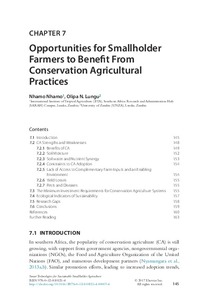| dc.contributor.author | Nhamo, N. |
| dc.contributor.author | Lungu, O.N. |
| dc.date.accessioned | 2019-12-04T11:15:34Z |
| dc.date.available | 2019-12-04T11:15:34Z |
| dc.date.issued | 2017 |
| dc.identifier.citation | Nhamo, N. & Lungu, O.N. (2017). Opportunities for smallholder farmers to benefit from conservation agricultural practices. In N. Nhamo, D. Chikoye and T. Gondwe, Smart technologies for sustainable smallholder agriculture, Amsterdam, The Netherlands: Elsevier, (p. 145-163). |
| dc.identifier.isbn | 978-0-12-810521-4 |
| dc.identifier.uri | https://hdl.handle.net/20.500.12478/2994 |
| dc.description.abstract | Conservation agriculture (CA) practices combine the use of soil cover, crop combinations, and reduced tillage. There has been widespread promotion of CA practices in southern Africa. The aim of this chapter is to take stock of the advances in understanding the CA systems and to define the benefits of CA to smallholder farmers and where it can best be applied. Research results have shown an improved understanding of how the systems impact production potential and an indicative direction of where the systems may work and where challenges lie. Given the changes in climate and the challenges with soils that may not respond to soil amendments, it is important to define boundary conditions under which CA techniques will deliver on improving production and at the same time mitigate the effects of climate change through improved resource use efficiency.
CA has the potential to improve crop yields, soil organic matter content, soil infiltration rates, and microsites for proliferation of beneficial soil organisms. However, smallholder farmers require financial resource to expand the area under CA beyond the small trial plots for benefits to accrue over a wider area, invest into new equipment, and effectively use agrochemicals. Farmers living in dire poverty may not be able to adopt CA effectively. More data is required to characterize the farmer typology which can effectively apply CA as a climate smart technology. |
| dc.format.extent | 145-163 |
| dc.language.iso | en |
| dc.publisher | Elsevier |
| dc.subject | Maize |
| dc.subject | Conservation Agriculture |
| dc.subject | Tillage |
| dc.subject | Rotation |
| dc.subject | Smallholders |
| dc.title | Opportunities for smallholder farmers to benefit from conservation agricultural practices |
| dc.type | Book Chapter |
| dc.description.version | Peer Review |
| cg.contributor.crp | Maize |
| cg.contributor.crp | Roots, Tubers and Bananas |
| cg.contributor.affiliation | International Institute of Tropical Agriculture |
| cg.contributor.affiliation | University of Zambia |
| cg.coverage.region | Africa |
| cg.coverage.region | Central Africa |
| cg.coverage.region | East Africa |
| cg.coverage.region | Southern Africa |
| cg.coverage.country | Congo, Dr |
| cg.coverage.country | Malawi |
| cg.coverage.country | Mozambique |
| cg.coverage.country | South Africa |
| cg.coverage.country | Tanzania |
| cg.coverage.country | Zambia |
| cg.coverage.country | Zimbabwe |
| cg.creator.identifier | Nhamo: 0000-0002-1182-6014 |
| cg.authorship.types | CGIAR and developing country institute |
| cg.iitasubject | Farming Systems |
| cg.iitasubject | Plant Production |
| cg.iitasubject | Smallholder Farmers |
| cg.howpublished | Formally Published |
| cg.publicationplace | Amsterdam, The Netherlands |
| cg.accessibilitystatus | Limited Access |
| local.dspaceid | 94414 |
| cg.targetaudience | Scientists |
| cg.identifier.doi | http://dx.doi.org/10.1016/b978-0-12-810521-4.00007-4 |

